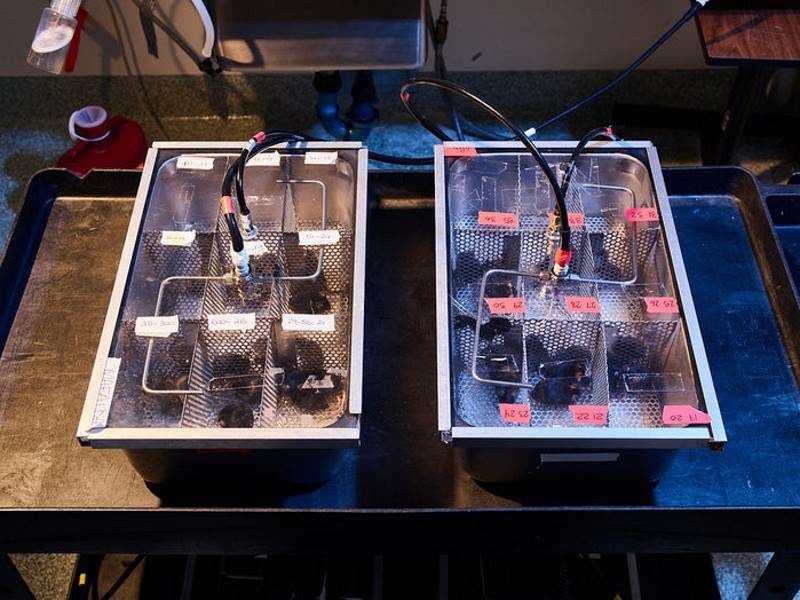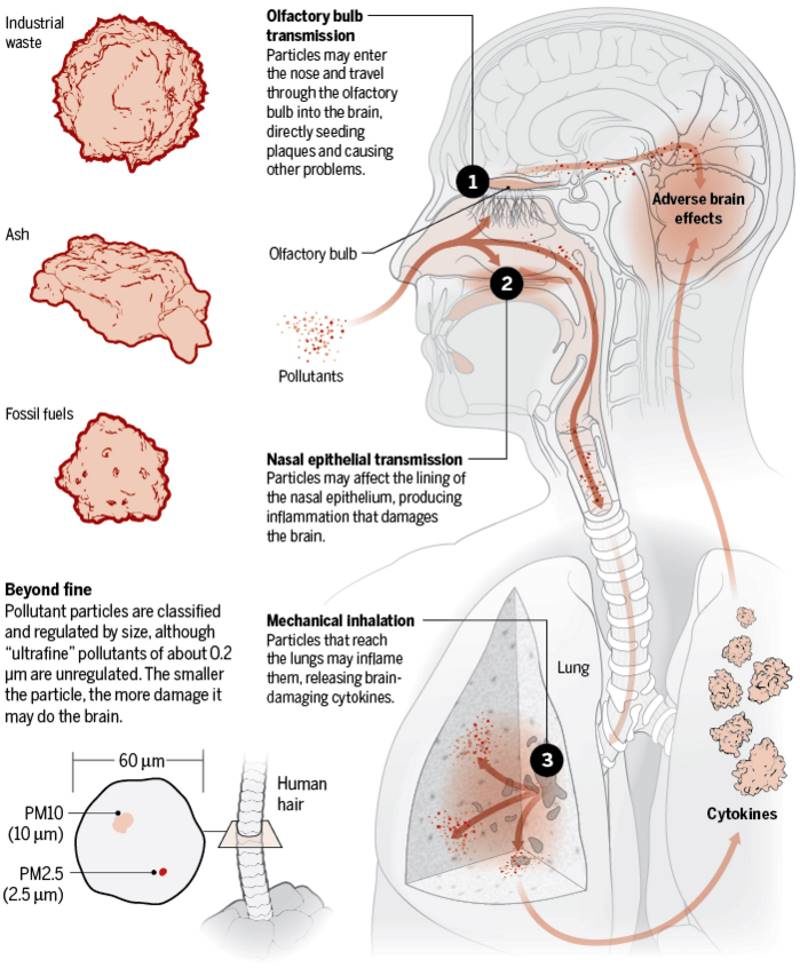
In a barbed wire-enclosed parking lot 100 meters downwind of the Route 110 freeway, an aluminum hose sticks out of a white trailer, its nozzle aimed at an overpass. Every minute, the hose sucks up hundreds of liters of air mixed with exhaust from the roughly 300,000 cars and diesel-burning freight trucks that rumble by each day.
Crouched inside the trailer, a young chemical engineer named Arian Saffari lifts the lid off a sooty cylinder attached to the hose, part of a sophisticated filtration system that captures and sorts pollutants by size. Inside is a scientific payload: particles of sulfate, nitrate, ammonium, black carbon, and heavy metal at least 200 times smaller than the width of a human hair.
The particles are too fine for many air pollution sensors to accurately measure, says Saffari, who works in a lab led by Constantinos Sioutas at the University of Southern California (USC) here. Typically smaller than 0.2 µm in diameter, these "ultrafine" particles fall within a broader class of air pollutants commonly referred to as PM2.5 because of their size, 2.5 µm or less. When it comes to toxicity, size matters: The smaller the particles that cells are exposed to, Saffari says, the higher their levels of oxidative stress, marked by the production of chemically reactive molecules such as peroxides, which can damage DNA and other cellular structures.
Some of the health risks of inhaling fine and ultrafine particles are well-established, such as asthma, lung cancer, and, most recently, heart disease. But a growing body of evidence suggests that exposure can also harm the brain, accelerating cognitive aging, and may even increase risk of Alzheimer's disease and other forms of dementia.
The link between air pollution and dementia remains controversial - even its proponents warn that more research is needed to confirm a causal connection and work out just how the particles might enter the brain and make mischief there. But a growing number of epidemiological studies from around the world, new findings from animal models and human brain imaging studies, and increasingly sophisticated techniques for modeling PM2.5 exposures have raised alarms. Indeed, in an 11-year epidemiological study to be published next week in Translational Psychiatry, USC researchers will report that living in places with PM2.5 exposures higher than the Environmental Protection Agency's (EPA's) standard of 12 µg/m3 nearly doubled dementia risk in older women. If the finding holds up in the general population, air pollution could account for roughly 21% of dementia cases worldwide, says the study's senior author, epidemiologist Jiu-Chiuan Chen of the Keck School of Medicine at USC.
Deepening the concerns, this month researchers at the University of Toronto in Canada reported in The Lancet that among 6.6 million people in the province of Ontario, those living within 50 meters of a major road - where levels of fine pollutants are often 10 times higher than just 150 meters away - were 12% more likely to develop dementia than people living more than 200 meters away.
The field is "very, very young," cautions Michelle Block, a neuroscientist at Indiana University in Indianapolis. Nonetheless, it's a "hugely exciting time" to study the connections between pollution and the brain, she says. And if real, the air pollution connection would give public health experts a tool for sharply lowering Alzheimer's risks - a welcome prospect for a disease that is so devastating and that, for now, remains untreatable.
Demented dogs in Mexico City in the early 2000s offered the first hints that inhaling polluted air can cause neurodegeneration. Neuroscientist Lilian Calderón-Garcidueñas, now at the University of Montana in Missoula, noticed that aging dogs who lived in particularly polluted areas of the city often became addled, growing disoriented and even losing the ability to recognize their owners. When the dogs died, Calderón-Garcidueñas found that their brains had more extensive extracellular deposits of the protein amyloid b-the same "plaques" associated with Alzheimer's disease-than dogs in less polluted cities. She went on to find similarly elevated plaque levels in the brains of children and young adults from Mexico City who had died in accidents, as well as signs of inflammation such as hyperactive glia, the brain's immune cells. Calderón-Garcidueñas's studies didn't have rigorous controls, or account for the fact that amyloid b plaques don't necessarily signal dementia. But later work lent weight to her observations.
Those tubes of fine particles from the 110 freeway have played a key role. In a basement lab at USC, Sioutas and his team aerosolize the pollutants with a hospital nebulizer, then pipe the dirty air into the cages housing lab mice that have been engineered to contain a gene for human amyloid b. Control animals housed in the same room breathe clean, filtered air. After a designated period - 220 hours over several weeks, in a recent experiment - the team hands the rodents over to colleagues at USC, who kill the animals and check their brains for signs of neurodegeneration.

Just how the fine airborne particles might travel from a rodent's nasal cavity to its brain is a mystery. But a research team led by Günter Oberdörster at the University of Rochester in New York has used traceable, radioactive specks of elemental carbon to demonstrate that inhaled particles smaller than 200 nanometers can get through the delicate tissues lining a rodent's nasal cavities, travel along neurons, and spread as far as the cerebellum, at the back of the brain, triggering an inflammatory reaction.
To understand what the animal studies might mean for people, however, scientists need to correlate air pollution exposure with human brain scans and with results from rigorous cognitive testing.
That's not easy to do, as long-term, historical data on pollution exposures are scarce in the United States and many other countries, says Kimberly Gray, a program administrator at the National Institute of Environmental Health Sciences (NIEHS) in Durham, North Carolina. But in a September 2016 review of 18 epidemiological studies from Taiwan, Sweden, Germany, China, the United Kingdom, and the United States, all but one showed an association between high exposure to at least one component of air pollution and a sign of dementia. The review, published in Neurotoxicology, included a 2012 analysis of 19,000 retired U.S. nurses, which found that the more fine particulates the nurses were exposed to, based on monitoring data near their homes, the faster they declined on cognitive tests. For every additional 10 micrograms per cubic meter of air they breathed, their performance on tests of memory and attention declined as if they had aged by 2 years, says Jennifer Weuve, an epidemiologist at Boston University, who led the analysis.

Shortly after that study was published, USC's Chen reported another example of brain shrinkage: In 1403 elderly women, the total volume of white matter - the insulated nerve fibers that connect different brain regions - decreased by about 6 cubic centimeters for every 3.5-µg/m3 increase in estimated PM2.5 exposure, based on air monitoring data from participants' residences for 6 to 7 years before the brain scans were taken. Chen's white matter findings are consistent with studies of cultured neurons, which show that exposure to PM2.5 can cause myelin - the fatty insulation that wraps around neuronal axons - to "peel up at the ends, like a Band-Aid," Block says.
Modes of attack
Pollutant particles might make their way to the brain and damage it directly, or they might attack it from a distance, by triggering the release of inflammatory molecules.
Where the risk is greatest is far from clear. Burning just about anything produces PM2.5: oil and gas, firewood, vegetation. Federal- and state-funded networks of air quality monitors in the United States get turned off and on according to political whim, and are frustratingly uneven. According to the American Lung Association less than a third of U.S. counties have ozone or particle pollution monitors, and coverage is especially sparse in rural areas. Those that exist have only measured PM2.5 since 1997-before that, EPA did not monitor particles smaller than PM10.
Over the past several years, however, new computational models have made it possible to fill in some of the gaps in monitoring data, Gray says. In September 2016, NIEHS and the National Institute on Aging launched several new epidemiological studies that will use such modeling to look at the link between air pollution and brain health. One, based in Seattle, Washington, will estimate participants' lifetime exposure to PM2.5 pollution and correlate it with the incidence of dementia, says Lianne Sheppard, a biostatistician at the University of Washington in Seattle.
For their study of the Seattle region, Sheppard and her colleagues will take advantage of a model they developed for an earlier study of air pollution and atherosclerosis. Creating it, she says, took "a huge amount of behind-the-scenes work." First, they compiled more than a decade of air monitoring data on PM2.5 and other pollutants from 600,000 locations across the United States. For each location, they calculated 800 different geographic variables, such as the distance to ports, factories, refineries, residual oil, and roads. Then they fitted their models to the monitoring data using a 25-by-25-meter grid and estimated PM2.5 concentrations in each grid cell.
Building on the model, Sheppard and colleagues will create an even more detailed estimate of past air pollution levels in and around Seattle. To survey dementia in the region, the team will tap the Adult Changes in Thought study, which has monitored 5000 elderly people in the Seattle area for more than 20 years. Although all the participants were cognitively normal when they joined, at age 65 or so, roughly 1000 have since developed dementia, including 859 Alzheimer's cases. When the participants die and donate their brains to science, as more than 600 already have, pathologists examine their brain tissue for abnormal protein deposits, cerebrovascular damage, and other signs of cellular stress. Combined with genetic studies, Sheppard says, such analyses will allow her group to probe "not just the epidemiology of the relationship between air pollution and cognition, but start drilling down to mechanisms" that explain how airborne pollutants affect the human brain.
Some people may be more susceptible than others. In the Translational Psychiatry study, Chen's team found that women carrying the Alzheimer's risk gene APOE4 faced a disproportionately higher risk from pollution. And recently, Finch has started to examine the overlap - and potential synergy - between PM2.5 and cigarette smoke. The smoke is itself rich in ultrafine particles and can trigger the production of amyloid plaques and neuroinflammation in mouse models. Although smoking was once considered protective against Alzheimer's, prospective studies have since established tobacco smoke as a major risk factor, he says. In 2014, for example, a report published by the World Health Organization attributed as much as 14% of Alzheimer's disease worldwide to smoking.
Pollution may take a greater cognitive toll on the poor, in part because they are more likely to live in places with higher PM2.5 exposures, such as near major roadways or ports. Jennifer Ailshire, a USC sociologist, says stresses linked to poverty also could amplify the effects of the toxic particles. In one of her most recent studies, elderly people who rated their neighborhoods as stressful-citing signs of decay and disorder, such as litter and crime-did worse on cognitive tests than people who were exposed to similar pollution levels, but lived in less stressful neighborhoods, she says. "Living in L.A. [Los Angeles], we are all exposed to a lot of pollution, but some of us are fine," she says. When seeking to reduce the negative health impacts from air pollution, cities "might want to try to focus specifically on reducing pollution in communities particularly vulnerable to these exposures," she says.
But no one studying the suspected effects of pollutant particles on the brain is eager to do triage. If PM2.5 is guilty as charged, they say, the goal for policymakers worldwide should be to push down levels as far as possible. When all the research is in, Finch says, "I think [air pollution] will turn out to be just the same as tobacco-there's no safe threshold."
Reference: Science, doi:10.1126/science.aal0656
Emily Underwoood is a contributing correspondent for Science, covering neuroscience.




Comment: